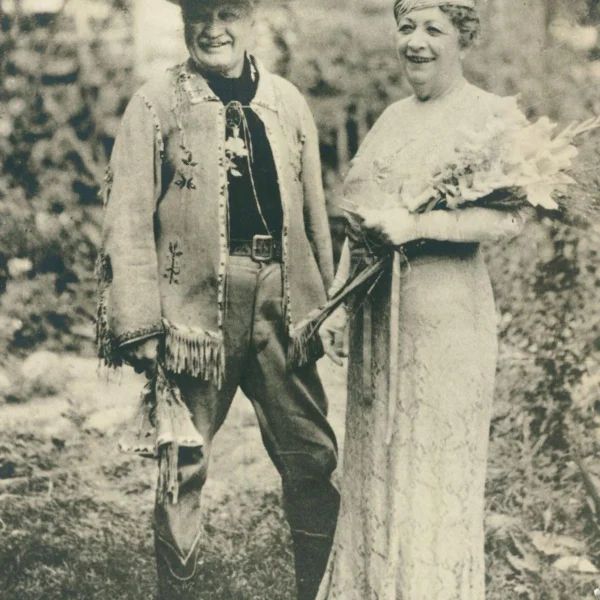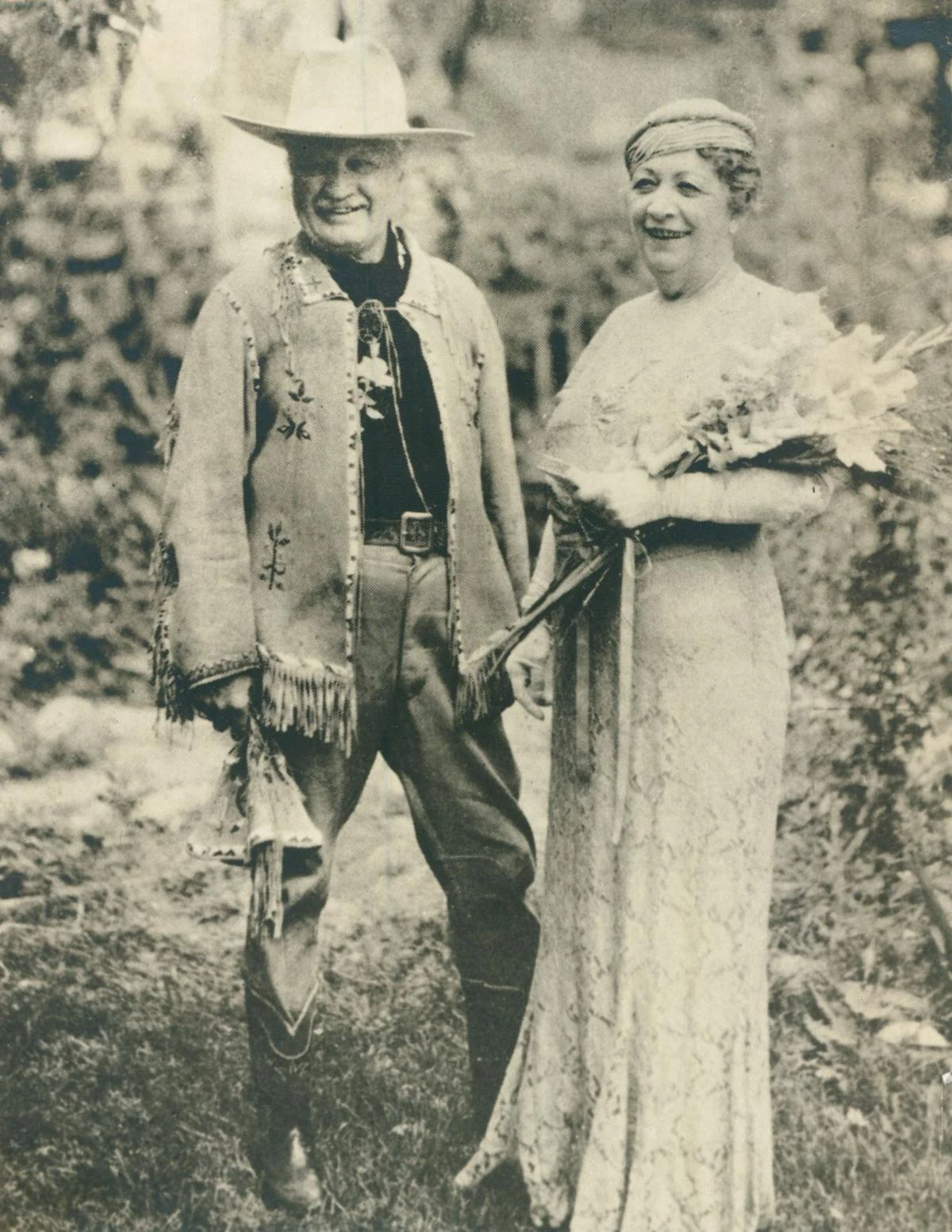The life and times of Bloomington-born Gordon William “Pawnee Bill” Lillie show us that when it comes to the Wild West, it’s often hard to separate the myths from the real-world events. “When the legend becomes fact, print the legend,” was the way it was put in the John Ford western “The Man Who Shot Liberty Valance.”
Pawnee Bill ventured out West in the late 1870s, spending several years living what was once called the “picturesque” life—one filled with high adventure on horseback, shooting buffalo and befriending Native Americans. Yet as early as 1883, he embarked on a career as a Wild West showman, helping stage fanciful recreations of the days, apparently not so long ago, when the “noble savage,” the cowboy and the outlaw roamed the trackless plains.
Lillie was born in Bloomington on Valentine’s Day 1860, growing up on what’s today West MacArthur Avenue (the house still stands). It was said that before venturing westward, “he had never ridden a horse or shot a gun.” Interviewed in 1940, Lillie recalled that as a youth he was so frail that a friend’s father, a butcher, tried to toughen him up by having him drink the warm blood of freshly slaughtered beef cattle.
While still a teenager, Lillie taught for a while at Brush College, the whimsical name of a one-room school in Arrowsmith Township west of Bloomington. “The school had a bad reputation, teachers sometimes lasted but a few days,” recounted one county schools superintendent. Lillie promised to handle the situation or forgo his pay, and on his first day the “tough boys and bullies” who controlled the rural school confronted him in a manner most unfriendly. “The 17-year-old teacher warned them, but they heeded not,” the story goes. Lillie then “rushed the leader grabbing him by the long hair, threw him to the center of the room just missing a red-hot stove. After the third boy hit the floor, all was quiet.”
Lillie’s father left for Kansas around this time to establish a milling business, promising to send for the family once he settled in. Lillie, apparently infatuated with the West by this time, couldn’t wait. “I ran off from home and by freight trains, wagons and on foot, made my way to the Indian Territory [Oklahoma],” he later recalled.
According to one retelling of his early years in the wild and wooly southern Great Plains (and there are several competing versions), Lillie worked for a trapping outfit shooting buffalo. After a year playing his part in the near-extirpation of the American bison (a role he later came to regret), Lillie found his life’s calling among the Pawnee, learning their language and eventually becoming an interpreter and secretary for a government Indian agent.
This also being the Wild West of legend and lore, it’s said that once, while caught in a winter storm hauling hides and furs, he found shelter with the Jesse James Gang. His adventures were also said to include “a narrow escape from a small band of Comanche Indians and deliverance from death beneath the hoofs of a huge heard of buffalo.”
In 1883 Lillie caught on as a Pawnee interpreter for William "Buffalo Bill" Cody’s traveling Wild West show, and the stage name “Pawnee Bill” would accompany Lillie the remainder of his long life. “In this way I drifted into the show business,” he wrote.
Five years later, in 1888, Lillie organized his own traveling show, which, like its many competitors, was similar to an outdoor circus, only instead of clowns and acrobats it showcased cowboys and Indians. By the end of his show business career he had taken his Wild West troupe throughout the United States, much of Canada, as well as overseas to places such as Belgium, Holland and France.
Interestingly, Lillie was not the only Wild West showman from McLean County. There was also Charles Jesse Jones, born in 1844 in Money Creek Township. “Buffalo” Jones, as he was known, was a Great Plains trailblazer, breeder of buffalo, consort to European royalty, Arctic explorer and cowboy of the East African Serengeti.
Pawnee Bill’s show came to Bloomington on several occasions. In August 1898, for instance, Lillie arrived in town with 300 performers and 58 Native Americans in tow, as well as 150 horses, costumes, elaborate props, canvas tents and all the accoutrements required of such entertainments.
Staged at the Illinois Wesleyan University ball field, the outdoor extravaganza featured a series of theatrically staged vignettes, including a band of Sioux attacking a Deadwood, SD stagecoach, a settler’s wagon, and a shack, only to be repelled each time. For the horse thief act, “a real human being was lassoed and dragged by a galloping horse across the park.” Other performances included Lillie’s wife Mary Emma, who “did some fancy shooting . . . breaking discs while at full speed on horseback.”
In March 1900, Miller Park, which kept a menagerie of animals (this was prior to the official establishment of the zoo), sold Lillie an ill-tempered buffalo for use in his traveling show. Five months later this “big rusty fellow” met a sad ending in Frankfort, Ind., when a center tent pole gave way during a rainstorm and landed on its back. “Mr. Lillie at once sent the head and a portion of the massive shoulders to Chicago to be stuffed,” it was reported.
That same summer of 1900, former Bloomington resident Erle H. Fuller wrote The Pantagraph detailing his life as a “rough rider” in Pawnee Bill’s show. He said a recent afternoon performance in Pittsburgh drew 12,000 paid spectators, with another 2,000 turned away due to lack of seating, and that President William McKinley was in the audience for an earlier show in Canton, OH. The shows four-legged performers included “200 fine horses, 2 buffalo, a drove of steer and ‘donks.’”
Lillie merged his Wild West show with "Buffalo Bill" Cody’s in 1908, and the “Two Bill’s” remained partners through 1913.
During this partnership Lillie completed his dream home, an imposing 14-room Arts and Crafts bungalow on Blue Hawk Peak, which overlooks the small community of Pawnee, Okla. Surrounding the house was a working ranch and what was claimed as the largest private bison herd in the world.
Gordon Lillie passed away at his ranch on February 3, 1942, less than two weeks before his 82nd birthday.
Today the Pawnee Bill Ranch and Museum is open to the public, and visitors can tour the stone bungalow which still contains original family furnishings. Each year in June, Lillie’s old Wild West show is brought back to life in all its peculiar glory.

